Folk music serves as a vital medium for cultural preservation and storytelling, capturing the essence of communities. This article explores its evolution through various cultures, the significance of storytelling traditions, and modern interpretations that blend traditional elements with contemporary genres. We will also examine regional variations and the challenges faced by folk musicians today in a rapidly changing musical landscape.
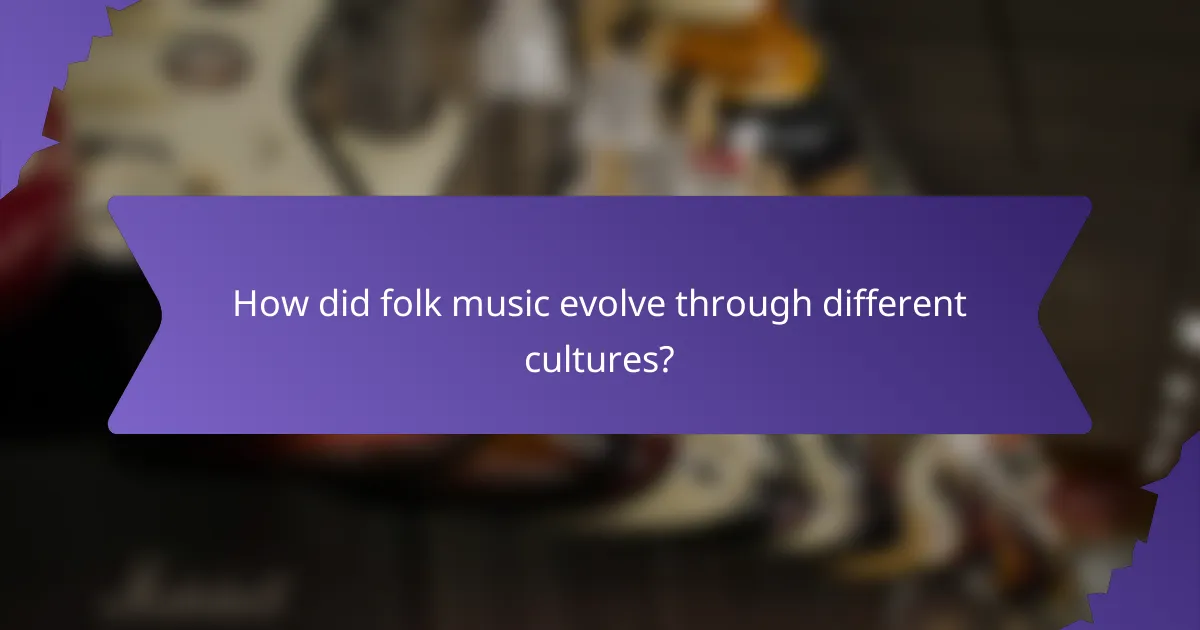
How did folk music evolve through different cultures?
Folk music evolved through various cultures by blending local traditions with influences from other musical forms. This evolution reflects the storytelling tradition, allowing communities to share their histories and experiences.
In Europe, folk music incorporated elements from classical and popular music, leading to diverse regional styles. For instance, Celtic music embraced storytelling through ballads and dance tunes, while Eastern European folk music often featured complex rhythms and harmonies.
In the Americas, folk music evolved from indigenous, African, and European influences. Genres like bluegrass and country music emerged, showcasing unique instruments and lyrical themes. The storytelling aspect remained central, with songs often addressing social issues and personal narratives.
Modern interpretations of folk music continue to thrive, as artists blend traditional elements with contemporary genres. This fusion keeps the essence of folk music alive while appealing to new audiences.
What are the common themes found in traditional folk music?
Traditional folk music commonly features themes of community, nature, and storytelling. These elements reflect cultural heritage and shared experiences. Storytelling serves as a way to convey history and morals, often through relatable characters and events. Nature is frequently depicted, symbolising the relationship between people and their environment. Additionally, social issues and personal struggles often emerge, allowing for emotional connection and reflection. The modern interpretations of these themes continue to evolve, maintaining relevance in contemporary society.
Which instruments are typically associated with folk music traditions?
Folk music traditions are often associated with instruments like the acoustic guitar, banjo, fiddle, accordion, and mandolin. These instruments contribute to the storytelling aspect of folk music, enhancing its cultural expression. The acoustic guitar serves as a foundational instrument, while the banjo and fiddle add unique regional flavours. The accordion and mandolin, though less common, enrich the sound palette of folk music.
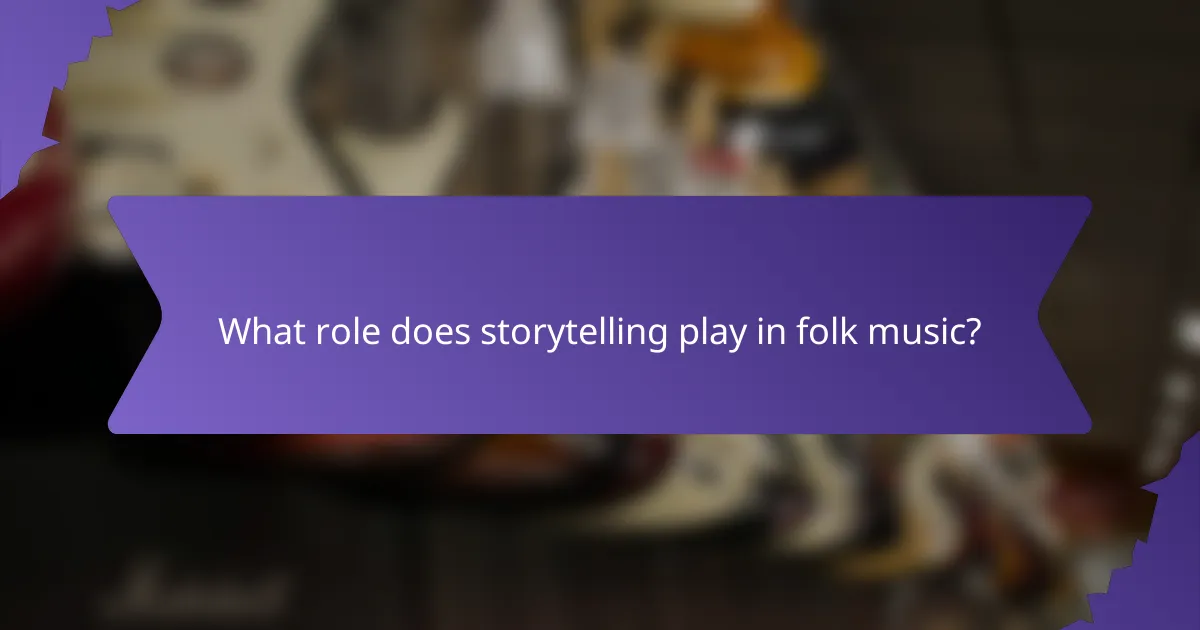
What role does storytelling play in folk music?
Storytelling is central to folk music, preserving cultural heritage and shared experiences. Through narratives, folk songs convey emotions, morals, and historical events, connecting generations. This tradition fosters community identity and continuity. Modern interpretations often blend these stories with contemporary themes, ensuring relevance while honouring roots.
How do narratives shape the identity of folk music?
Narratives significantly shape the identity of folk music by embedding cultural values and historical context. They convey collective experiences and emotions, allowing listeners to connect personally with the music. Folk music often reflects societal issues, preserving stories that resonate through generations. This storytelling tradition fosters community identity and continuity. Modern interpretations of folk music maintain these narratives while adapting to contemporary themes, ensuring relevance in today’s cultural landscape.
In what ways do folk songs reflect historical events?
Folk songs reflect historical events by narrating stories, preserving cultural memories, and expressing collective emotions. These songs often serve as oral history, capturing significant moments like wars, migrations, and social changes. For instance, during the American Civil War, folk songs conveyed the struggles and hopes of soldiers and families. Additionally, folk music adapts over time, incorporating contemporary issues while maintaining roots in past events. This storytelling tradition fosters a sense of identity and continuity within communities.
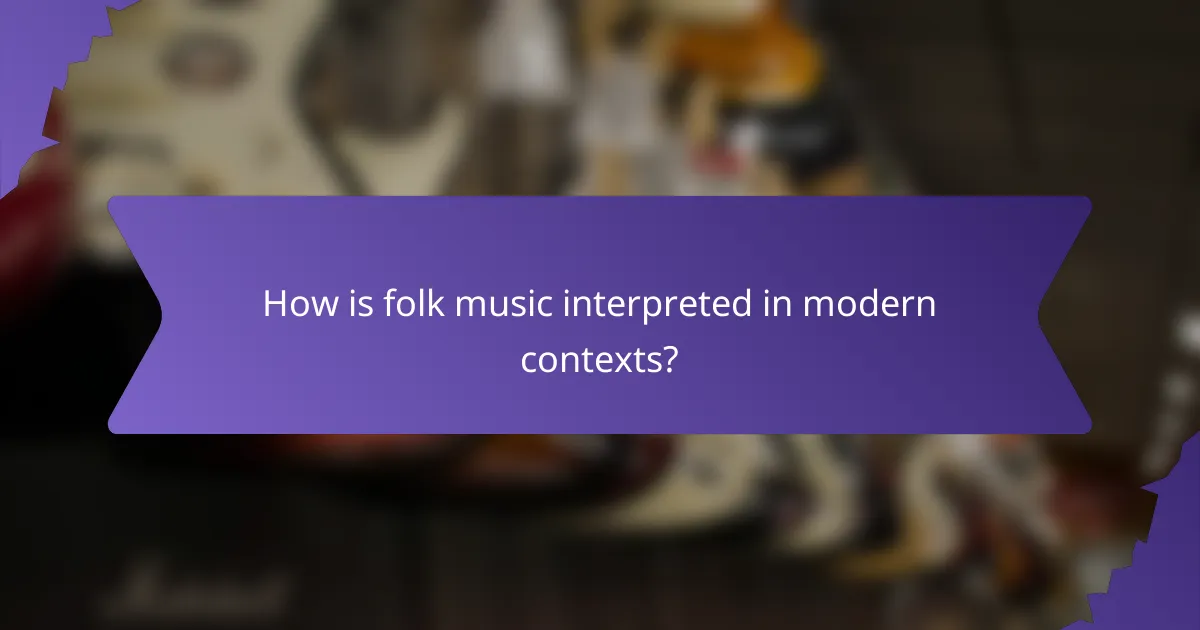
How is folk music interpreted in modern contexts?
Folk music is interpreted in modern contexts as a dynamic blend of tradition and contemporary influences. It retains its storytelling roots while adapting to diverse genres and cultural expressions. Artists often fuse folk elements with pop, rock, or electronic music, creating innovative sounds that resonate with younger audiences. This evolution highlights folk music’s unique attribute of versatility, allowing it to address modern social issues and personal narratives. As a result, folk music remains relevant, fostering community connections and preserving cultural heritage.
Which contemporary artists are redefining folk music?
Contemporary artists redefining folk music include Phoebe Bridgers, Brandi Carlile, and The Tallest Man on Earth. These musicians blend traditional elements with modern themes, expanding the storytelling tradition of folk music.
Phoebe Bridgers incorporates introspective lyrics and indie rock influences, while Brandi Carlile combines folk with Americana and pop. The Tallest Man on Earth adds a unique vocal style and intricate guitar work, showcasing the genre’s versatility.
Additionally, artists like Laura Marling and Hozier draw from folk roots, infusing their music with personal narratives and social commentary. This evolution reflects a broader trend of folk music adapting to contemporary issues and diverse musical landscapes.
What are the influences of technology on modern folk music?
Technology significantly influences modern folk music by enhancing accessibility, enabling collaboration, and fostering innovation. Digital platforms allow artists to reach global audiences, while social media facilitates community engagement. Additionally, technology introduces new sounds and production techniques, enriching the storytelling tradition. The unique attribute of modern folk music lies in its ability to blend traditional elements with contemporary influences, creating a diverse and evolving genre.
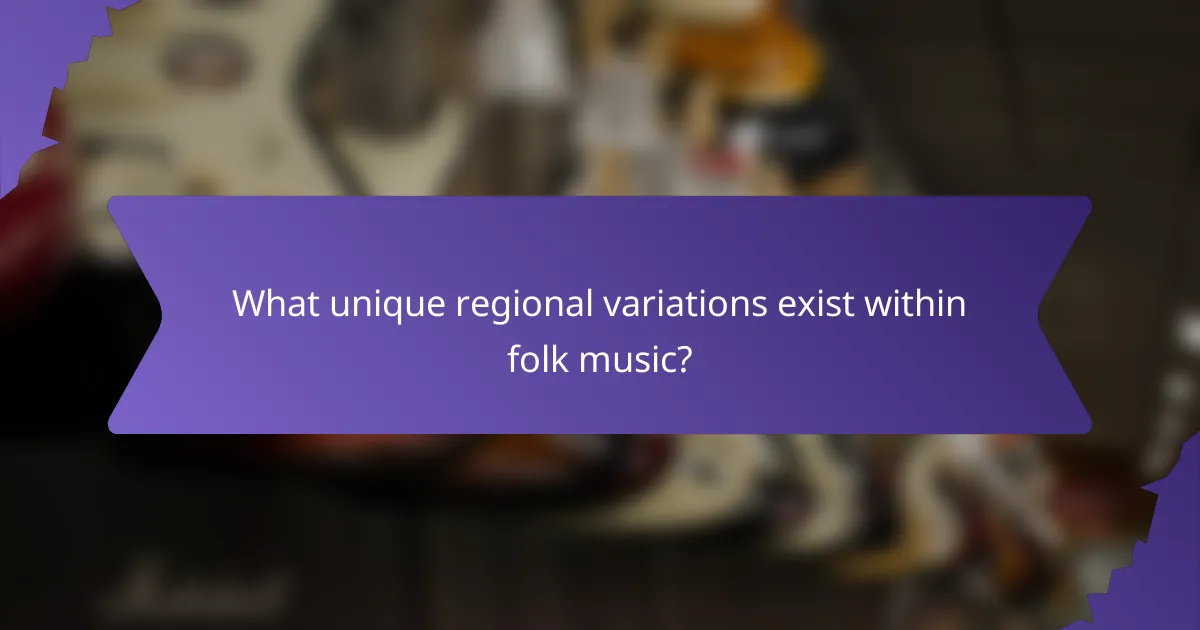
What unique regional variations exist within folk music?
Folk music exhibits unique regional variations shaped by cultural influences and local traditions. For instance, Appalachian folk music features storytelling through ballads, while Cajun music incorporates French influences and lively rhythms. In contrast, Irish folk music emphasises traditional instruments like the fiddle and bodhrán. Each region’s history and social context significantly influence its musical style and themes. This diversity reflects the unique attributes of folk music as a living tradition that evolves while preserving cultural narratives.
How do cultural differences manifest in folk music styles?
Cultural differences in folk music styles manifest through diverse instruments, rhythms, and lyrical themes. Each culture infuses its unique history and traditions into music, shaping distinct sounds. For instance, Celtic folk music often features the fiddle and tin whistle, while African folk music prominently uses drums. Storytelling traditions vary, reflecting societal values and experiences. In modern interpretations, genres blend, showcasing globalization’s impact on preserving and evolving folk music.
What are some lesser-known folk music traditions around the world?
Folk music traditions worldwide are rich and varied, with many lesser-known styles. Notable examples include Sardinian cantu a tenore, a polyphonic style emphasising vocal harmonies, and the Tuvan throat singing, which produces multiple pitches simultaneously.
The Balinese gamelan music features intricate rhythms and is integral to cultural ceremonies. In the Andes, the charango, a small string instrument, accompanies traditional songs reflecting indigenous heritage. The Inuit throat singing, often performed by women, showcases a unique form of musical storytelling.
These traditions highlight the diverse ways communities express identity and history through music. Each style carries unique attributes that contribute to the global folk music tapestry.
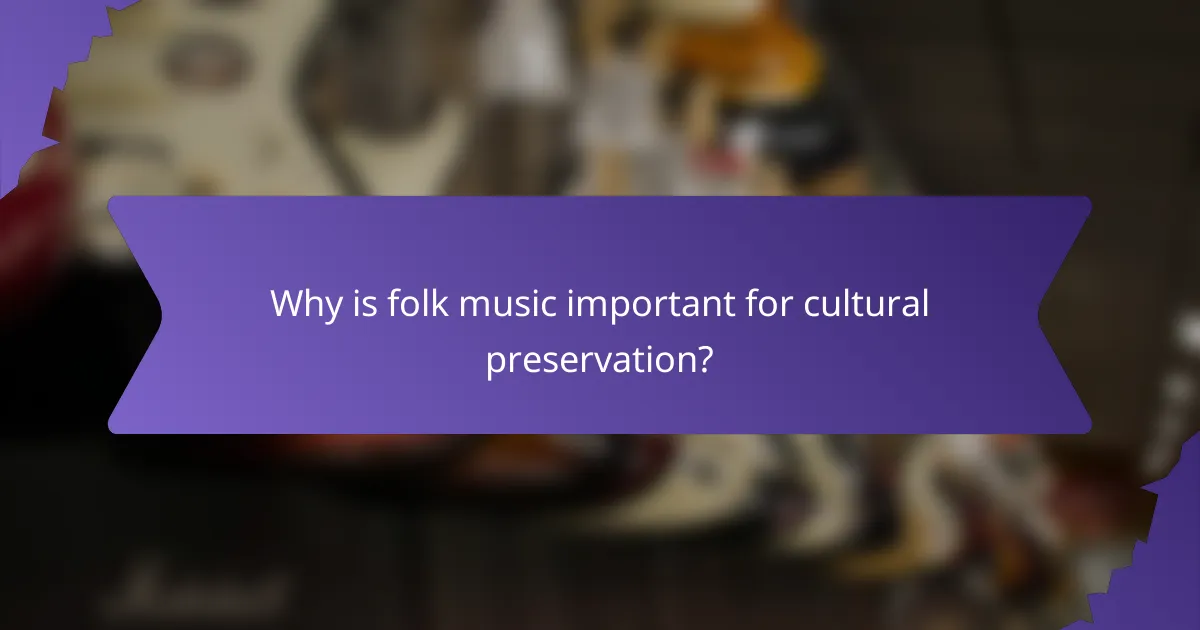
Why is folk music important for cultural preservation?
Folk music is crucial for cultural preservation as it embodies traditions, stories, and values of communities. This genre serves as a living archive, transmitting history and identity across generations. The storytelling aspect of folk music captures unique experiences and perspectives, fostering a sense of belonging. In modern interpretations, folk music adapts while maintaining its roots, ensuring relevance and engagement with new audiences. As a result, folk music not only preserves cultural heritage but also evolves, reflecting contemporary societal changes.
How do folk music festivals contribute to community engagement?
Folk music festivals significantly enhance community engagement by fostering connections among diverse groups. These events promote cultural exchange and storytelling, allowing participants to share personal and collective histories through music.
Local artists often perform, showcasing regional talent and traditions, which strengthens community identity. Festivals create spaces for collaboration, where attendees can participate in workshops and discussions, deepening their appreciation for folk music’s roots and modern interpretations.
Moreover, folk music festivals can boost local economies by attracting visitors, benefiting businesses and creating job opportunities. The shared experience of music fosters a sense of belonging and unity, encouraging ongoing community involvement beyond the event itself.
What impact does folk music have on social movements?
Folk music significantly influences social movements by fostering community identity and conveying powerful messages. Its roots in storytelling traditions allow artists to express social and political issues, mobilising listeners for change. For example, during the civil rights movement, songs like “We Shall Overcome” united people and inspired action. Additionally, modern interpretations continue this legacy, adapting folk music to resonate with contemporary struggles, thus maintaining its relevance in activism.
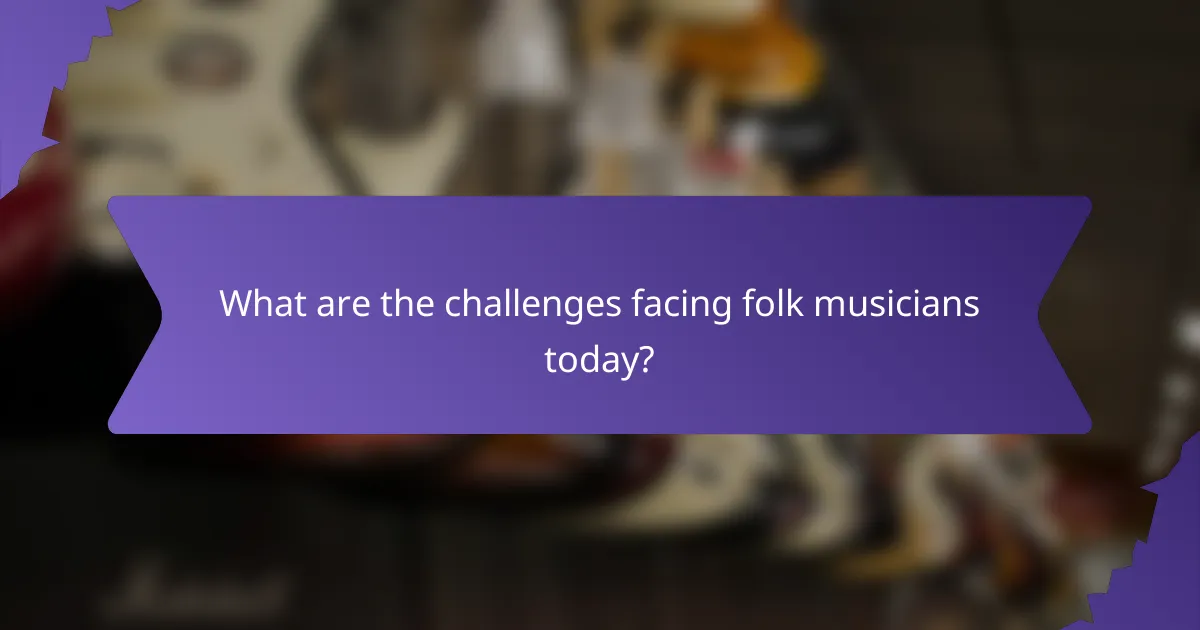
What are the challenges facing folk musicians today?
Folk musicians today face several challenges that affect their craft and sustainability. The digital landscape has transformed music distribution, making it harder for folk artists to stand out among numerous genres. Additionally, the decline of traditional venues limits performance opportunities, impacting exposure and income. Competition from mainstream music and changing listener preferences further complicate their efforts to reach audiences. Finally, the struggle to maintain authenticity while adapting to modern trends poses a unique challenge for preserving the storytelling tradition of folk music.
How can folk musicians adapt to changing audience preferences?
Folk musicians can adapt to changing audience preferences by embracing modern technology, collaborating with diverse genres, and focusing on storytelling. They should leverage social media platforms to reach wider audiences and engage directly with fans. Additionally, incorporating contemporary themes into their lyrics can resonate more with today’s listeners. This approach maintains the essence of folk music while ensuring relevance in a rapidly evolving musical landscape.
What resources are available for aspiring folk musicians?
Aspiring folk musicians can access various resources to enhance their skills and knowledge. Local music schools offer classes focused on folk instruments and songwriting techniques. Online platforms like YouTube provide free tutorials and performances from established artists. Music festivals often feature workshops and networking opportunities with industry professionals. Additionally, folk music associations and community groups can connect musicians with mentors and collaborative opportunities.
What best practices can enhance the reach of folk music?
To enhance the reach of folk music, artists should leverage digital platforms, collaborate with diverse genres, and engage local communities. Utilizing social media allows for wider audience interaction and promotion. Collaborations can introduce folk music to new listeners, bridging gaps between genres. Community events foster local support and participation, enriching the folk tradition.